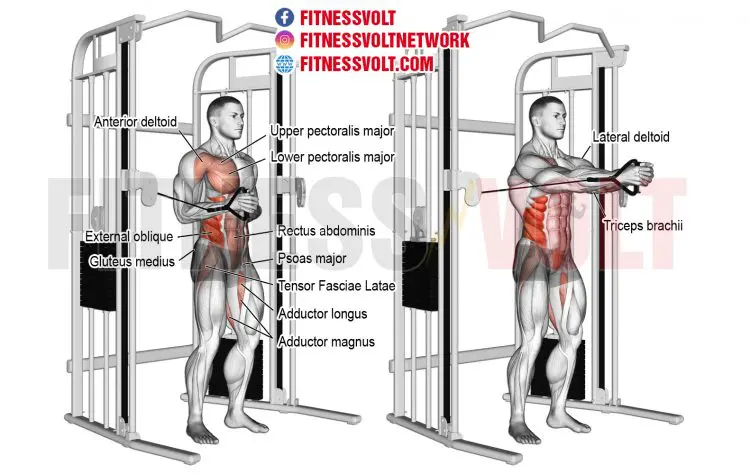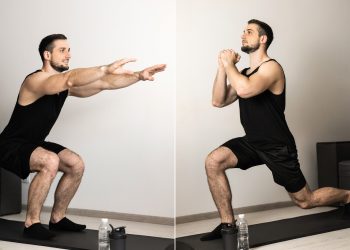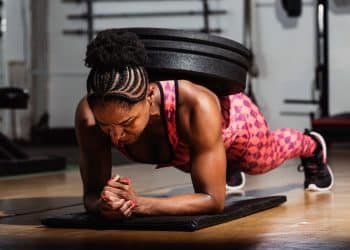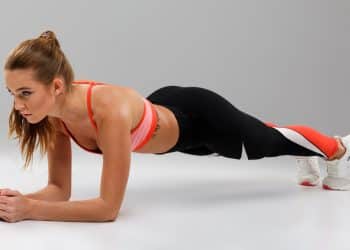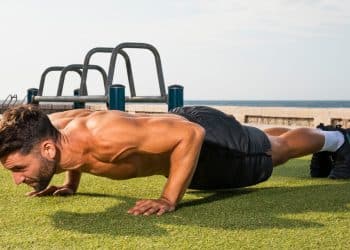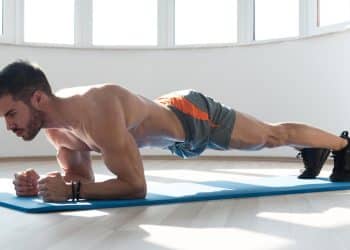While there is nothing inherently wrong with exercises like sit-ups, crunches, and leg raises, they don’t really train your midsection as it works in nature. Rather than generating movement, the core muscles tend to prevent unwanted movement, acting as stabilizers rather than prime movers.
For example, when you run, jump, lift, pull, or push, the muscles of your midsection contract and brace to fix your lumbar spine in place and increase intra-abdominal pressure, supporting your lower back from within.
As such, most lifters need to include static or stationary exercises as well as more dynamic movements in their midsection workouts.
In this article, we compare and contrast two classic core exercises, Pallof presses and planks, so you can determine which one is best for you.
What is The Pallof Press?
The Pallof press was invented by Bostonian physical therapist John Pallof back in the early 2000s. It was quickly picked up by fitness and athletic trainers and became a popular core developer, especially with so-called functional exercisers.
Level Up Your Fitness: Join our 💪 strong community in Fitness Volt Newsletter. Get daily inspiration, expert-backed workouts, nutrition tips, the latest in strength sports, and the support you need to reach your goals. Subscribe for free!
Pallof himself called this movement the belly press, but it’s also known as the core chest press, the cable core press, and the anti-rotation press.
In simple terms, the Pallof press is a standing cable chest press during which you must use your core muscles to resist rotation. As such, it’s an isometric anti-rotation core exercise more than a chest exercise. However, you will probably feel some chest and triceps engagement during this exercise.
Muscles Worked
Pallof presses are a core exercise. Core is the collective term for the muscles of the midsection. The main core muscles are:
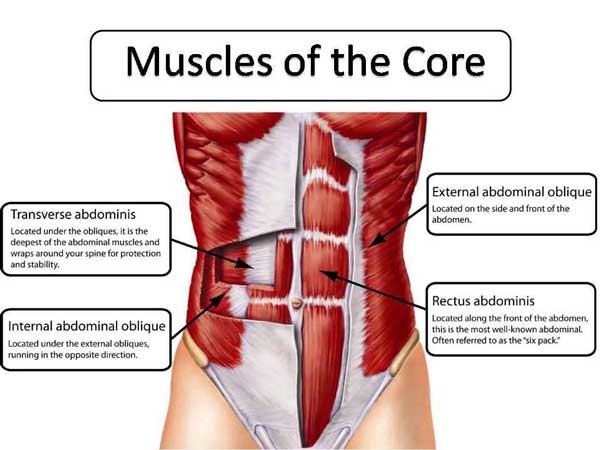
Rectus abdominis
Located at the front of your abdomen, the rectus abdominis is a long, flat muscle divided into horizontal and vertical sections by bands of ligamentous tissue. This gives it a unique six-pack appearance.
The rectus abdominis flexes your spine forward, flexes it laterally, and also compresses the abdominal contents to increase intra-abdominal pressure for improved core stability.
Obliques
Located on the sides of your waist, the obliques are responsible for lateral flexion and rotation of your spine. The obliques are very active during Pallof presses and must work hard to prevent your shoulders or hips from twisting. There are two sets of oblique muscles – internal and external – and both are active during Pallof presses.
Transverse abdominis
Known as the TVA for short, transverse abdominis encircles your waist like a corset or weightlifting belt. When TVA contracts, it squeezes inward to create intra-abdominal pressure or IAP. IAP helps support and stabilize your spine from within, taking pressure off your intervertebral discs.
During Pallof presses, the core muscles work isometrically. That means they generate tension without changing length.
Pectoralis major, anterior deltoids, triceps
While not the target of the exercise, the pecs, front delts, and triceps have a vital part to play during Pallof presses. You use these muscles to extend your arms and increase the leverage and load on your core muscles.
However, overload is quite limited, and Pallof presses probably won’t do all that much for your upper body pressing strength. If that’s what you want, bench presses, chest presses, and push-ups would be a better choice.
How to do Pallof presses
Get the most from Pallof presses by performing them correctly!
- Attach a D-shaped handle to a chest-high cable machine. Stand sideways to the weight stack and hold the handle in both hands in front of your chest.
- Square your shoulders and hips, bend your knees slightly for balance and pull your shoulders down and back. Brace your core.
- Without twisting your hips or shoulders, extend your arms out in front of you at shoulder height. Pause with your arms straight. Note how the tension on your core increases as you straighten your arms.
- Bring your hands back to your chest and repeat.
- Do the required number of reps, rest a moment, and then swap sides and repeat.
Tips:
- Inhale as you extend your arms, and exhale as you bring your hands back to your chest to maximize intra-abdominal pressure.
- You can also do this exercise in a staggered or half-kneeling position for variation.
- No cable machine? No problem! Do Pallof presses with a resistance band, like this:
Pallof Press – Pros
Not sure if Pallof presses are the right core exercise for you? Consider these benefits and then decide!
A very functional exercise
Pallof presses mirror how the core muscles function in nature, i.e., bracing the lumbar spine and preventing unwanted movement while the upper and/or lower body performs dynamic activities. Training your muscles as they usually operate will have a positive effect on your performance of everyday and athletic functions.
Infinitely scalable
Unlike most bodyweight core exercises, you can easily adjust the resistance when performing cable Pallof presses. They can be performed anywhere on the strength-to-endurance spectrum using heavy, light, or medium weights. It also means they’re suitable for all levels of exerciser, from raw beginners to experienced and advanced.
Very accessible
Most gyms have adjustable cable machines suitable for Pallof presses, and there are cable machines made especially for home use. No cable machine? You can also do Pallof presses with a simple resistance band and a suitable anchor point.
Plenty of Pallof press variations
The basic Pallof press is a great exercise, but it’s not the only way to perform this movement. Other Pallof press variations include split stance, kneeling, half-kneeling, overhead, and Pallof presses using a partner.
You can read more about these variations here.
Pallof presses can be performed dynamically or isometrically
While Pallof presses are typically performed for reps, there is no law that says they have to be done that way. In some instances, a timed isometric hold may be better and will provide a more plank-like core workout. Simply extend your arms and then hold for a predetermined time, like this:
Pallof Press – Cons
While Pallof presses are undoubtedly an effective exercise, there are a couple of drawbacks to consider, too:
Equipment
At the very least, you need a resistance band to do Pallof presses, and an adjustable cable machine would be better. In contrast, many core exercises use nothing but body weight for resistance, making them far more accessible.
Not so good for developing rotational strength
Pallof presses are a strong anti-rotation exercise. However, that doesn’t mean they’ll do much for your dynamic rotational strength. If you want to, for example, throw the discus or do more powerful spinning roundhouse kicks, you’ll need exercises that involve more movement.
Not known for improving aesthetics
There is a reason you won’t see many bodybuilders doing Pallof presses – it’s not considered a good exercise for aesthetics. If you want to develop a tighter waist or more defined abs, there are other exercises that will be more helpful. In general, more dynamic movements are usually best for building muscle.
What is The Plank?
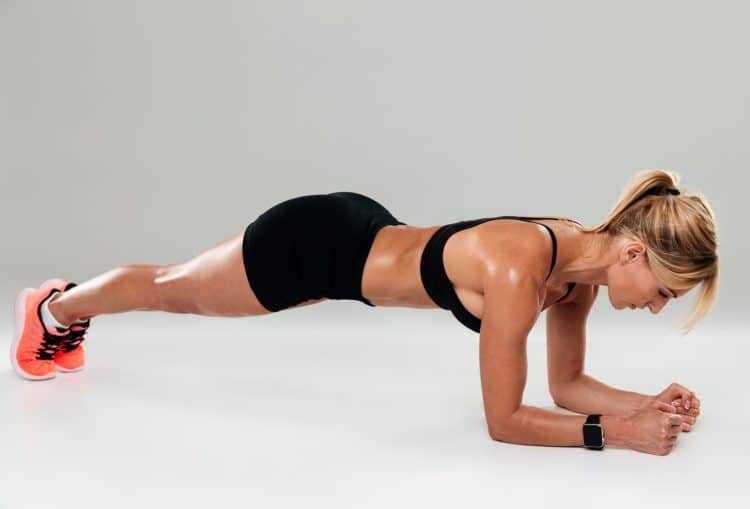
Planks could be the world’s favorite core exercise. But, contrary to what you might think, planks existed long before TikTok workout challenges became all the rage and actually came from Yoga and, later, Pilates.
By the way, the Guinness World Record for holding a plank is currently a frankly astounding nine hours, 30 minutes, and one second. So, planking for five minutes? Not really all that impressive!
Like Pallof presses, planks are an isometric exercise. However, this time, you’ll be using your core muscles to prevent spinal extension, so it’s an anti-extension exercise.
Basic front planks can be performed in several ways, including on your elbows, with straight arms, with one leg raised, with one arm raised, or with one leg AND one arm raised. Beginners can do planks resting on their knees, while more advanced exercisers may want to elevate their feet or rest their hands or elbows on a resistance ball.
Muscles Worked
Planks work many of the same muscles as Pallof presses. However, where Pallof presses work the core with an emphasis on the obliques, planks work the core muscles with an emphasis on the rectus abdominis.
That’s because Pallof presses are an anti-rotation exercise, whereas planks are an anti-extension exercise.
Because of this, most exercisers will probably benefit from doing both of these core conditioning moves.
Just to recap, the main muscles trained during planks are:
- Rectus abdominis
- Obliques
- Transverse abdominis
How to do planks
Get the most from planks by doing them right! Follow these step-by-step instructions:
Level Up Your Fitness: Join our 💪 strong community in Fitness Volt Newsletter. Get daily inspiration, expert-backed workouts, nutrition tips, the latest in strength sports, and the support you need to reach your goals. Subscribe for free!
- Kneel down and place your forearms on the floor. Your elbows should be directly below your shoulders, and your upper arms vertical. Clasp your hands together or leave your forearms parallel as preferred.
- Brace your core.
- Walk your feet out and back until your body is as straight as a plank. Tense your legs, glutes, chest, shoulders, and arms, as well as your core.
- Hold this position, but not your breath, for as long as possible. Keep your core braced and muscles tensed throughout. Do not allow your hips to lift or drop.
- At the end of your set, bend your legs and lower your knees to the floor.
Planks – Pros
Are planks the right exercise for you? Consider these pros and then decide!
Anywhere, anytime
Requiring no equipment, planks are a very convenient exercise that you can do almost anywhere and anytime. You can do planks at home, in a hotel room, at the beach, and even in jail! Planks are the ultimate excuse-free exercise.
No mat? No worries! Save your elbows and do your planks in the push-up position, the so-called high plank.
Easy to learn
Planks are a very straightforward exercise. Most people can self-learn this core classic and perform them correctly right from the get-go. There ARE things that can go wrong, like breath holding or dropping the hips, but these are usually easy to spot and fix.
A very functional exercise
Like Pallof presses, planks train your core muscles as they work in nature, i.e., isometrically and as a stabilizer. Doing planks could improve your athletic performance.
Less back pain
Back pain is a common complaint affecting as many as 80% of all adults. A stronger core can help reduce the risk of developing back pain, but unfortunately, exercises like crunches and sit-ups can actually cause discomfort and pain. Planks are well tolerated, and because there is no actual movement, they put very little stress on the lumbar spine.
A stronger core means less load on the discs and nerves of the lower back, stopping pain before it gets a chance to start.
Easy to progress or regress
The easiest way to make planks harder is to hold them for longer. However, you can also contract your core more intensely to fatigue your muscles faster. If you find regular planks too demanding, you can simply bend your legs and rest on your knees – the three-quarter plank. Move your knees closer to your elbows for a less challenging workout.
Planks – Cons
There aren’t too many drawbacks to doing planks, but the main cons are:
Too easy to focus too much on the duration
Many exercisers only focus on holding a plank for longer and longer durations. The truth is, once you can plank for three minutes or so, going for longer is largely a waste of time. So rather than turn planking into a marathon event, look for ways to make them more challenging. This will make much better use of your time.
Not the best exercise for core aesthetics
While planking can help tighten up your waistline, it’s not the sort of exercise that will thicken your abdominal wall and help you sculpt a six-pack. To build more muscular abs, you need to overload your core, which means things like cable crunches are superior to planks.
That’s not to say that planks are in any way ineffective. It’s just like they’re not necessarily the best exercise for building core muscle mass.
They can be kinda dull…
While Pallof presses are also an isometric exercise, at least you get to move your arms, so they’re a little more interesting. With planks, there is no such movement to take your mind off what you are doing. It’s just you, your core, and the clock…
As such, planks are not an especially exciting exercise. However, little tricks like rocking forward, backward, and side to side help shift the tension around your core, which may provide a welcome distraction.
Alternatively, you can try RKC planks, where you contract your core muscles as hard as possible to see how quickly you can fatigue them. 15-20 seconds is pretty typical.
Pallof Press vs. Planks: Judgement Time!
So, now that you know a little more about Pallof presses and planks, let’s judge these exercises by a few different criteria:
Strength
Both Pallof presses and planks will give you a stronger core. However, because planks use your body weight for resistance, they may not be as effective because most people tend to do them longer to make them more challenging. In contrast, Pallof presses allow you to lift progressively heavier weights, which is arguably the most efficient way to build strength.
Winner: Pallof presses
Hypertrophy
Isometric exercises are generally less effective for muscle hypertrophy than isotonic exercises. As such, neither Pallof presses nor planks will do much for the thickness of your abdominals. Instead, these exercises are better for building core strength and endurance than muscle mass. Therefore, if you want to develop thicker abs, you must perform exercises involving more movement, such as cable crunches or hanging knee raises.
Winner: It’s a draw, but neither is great for this purpose.
Safety
Pallof presses and planks involve no movement. This means they are very unlikely to cause injury. However, if either exercise is performed incorrectly, it could still hurt you. For example, if your hips sag during planks or you lose core tension during Pallof presses. That said, the chances of injuries with either of these exercises are very low.
Winner: It’s a draw!
Ease of learning
While both exercises are relatively straightforward, planks are probably easier to learn. After all, you don’t need to move and just have to get into and then maintain the correct body position. Pallof presses are also relatively simple, but because they involve movement, they may be more challenging for some exercisers to learn and master. Planks are suitable for even the most uncoordinated beginner.
Winner: Planks!
Accessibility and equipment
As you’re sure to already know, planks require no equipment. A mat will make them more comfortable, but it’s not essential, as you can always do high or push-up planks. In contrast, you need a cable machine or a resistance band to do Pallof presses. Planks are the perfect excuse-free, do-anywhere core exercise.
Winner: Planks!
Long-term progression
Assuming your cable machine has a big weight stack, you should be able to keep progressing with Pallof presses for a long time. Because of the nature of Pallof presses (long lever, weak movement), it’s unlikely that you’ll ever outgrow this exercise.
In contrast, the main progression with planks is to do them for longer and longer durations. This can become boring and even impractical, for example, if you work up to doing three sets of five minutes. Yes, there are variations and progressions for planks. Still, most of them only use your body weight for resistance, so your progress will eventually stall with them, too.
Winner: Pallof press
Variations
Both exercises offer variations. With planks, you can do side planks, single-arm planks, single-leg planks, single-arm and single-leg planks, planks on your hands, planks on a stability ball, etc. Pallof presses can be done standing, kneeling, half-kneeling, in a split stance, and overhead. Although we haven’t counted them up, there are probably as many plank variations as there are types of Pallof press.
Winner: It’s a draw – probably!
Pallof Press vs. Planks – Wrapping Up
Core strength is critical for most sporting and everyday activities. It can help protect you from back pain and could even improve your workout performance. Want to squat or deadlift more weight? A stronger core is a must.
While dynamic movements like crunches and sit-ups will strengthen your abdominals, they won’t do much for core stability, and that’s where moves like planks and Pallof presses come in. These exercises teach you how and improve your ability to stabilize your lumbar spine. The stronger your core is, the more stable your spine will be.
Are planks better than Pallof presses? Probably not. But these exercises ARE different. While planks are an anti-extension exercise, Pallof presses are an anti-rotation exercise. As such, most people should probably do both.
So, alternate between Pallof presses and planks or do them in the same workout to ensure your core is strong in all directions.
Interested in measuring your progress? Check out our strength standards for Bench Press, Cable Crunch, Push Ups, and more.

